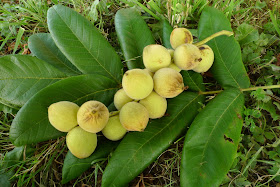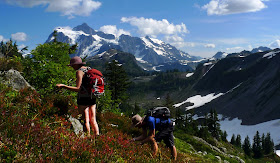 |
| Camp Islandwood on Bainbridge Island |
Last week Northwest Indian College’s
Institute for Indigenous Foods and Traditions organized a three day festival of
food on Bainbridge Island. The theme of this year’s inaugural conference was “Our
food is our medicine.” Indigenous harvesters, educators, , herbalists, dietitians, and
scholars shared workshops, stories, and foods from all corners of the Pacific
Northwest.
Highlights:
Terry Maresca presented on Bigleaf Maple
(Acer macrophyllum) tapping. Terry
comes from a long line of Mohawk sugarbush harvesters and when she moved to the
Pacific Northwest, she decided to start making maple syrup from our native
maples. We learned about the nutritional properties of maple syrup, how to
install taps, and good strategies for boiling the syrup. At the end, Terry gave us a taste of her very own Bigleaf Maple syrup. It was fantastic!
 |
| Leigh with a Riceroot bulb. (N. Turner photo) |
Later that day, Leigh Joseph presented
on her effort to restore Northern Riceroot (lhásem; Fritillaria camschatcensis) in the
mouth of the Squamish River so that the Squamish People can once again harvest
the edible bulbs. This project was part of her Master’s Degree research and she
employed both experimental and community-based research tools to simultaneously
understand the ecological and educational parameters for a successful ethno-ecological
restoration.
 |
| Elise's Fruit Leather |
 |
| Heather and her bounty of traditional foods |
That evening there was an open session for
participants to share food and recipes. Elise Krohn gave us samples of her excellent
Salal (Gaultheria shallon) - Blueberry
(Vaccinium sp.) fruit leather. Heather
shared a number of amazing foods that she and her boys harvested near Mt. Adams,
including Bitterroots (kioxhay*; Lewisia rediviva), Biscuitroots
(kaush*;
Lomatium canbyi.), Black Huckleberries (wiwnu*; Vaccinium membranaceum), dried Salmon
(nusux*),
and dried Elk (yamish*). She said that once the Biscuitroots have been sun
dried and mashed they are called luksh*. I have wanted to try
Bitterroots for years and I was very excited to taste them. Heather prepared
them by carefully peeling the roots and then drying them. She soaking them briefly in hot water before serving them. They were wonderful and not at
all bitter (maybe the slightest hint of bitter aftertaste).*Names provided by Heather, orthographies and any mistakes are my own.
 |
| Biscuitroot |
 |
| Bitterroot |
The next day the Alaska Native Tribal
Health Consortium presented on their traditional food revitalization project
called the “Store outside your door: hunt, fish, gather, grow!” They have
teamed with a chef to prepare a number of short food films featuring regional
and seasonal traditional foods throughout Alaska. Their films are phenomenal!
Check out their youtube
channel here.
 |
| Deer Butchering |
 |
| Hugh barbecuing Salmon and Venison |
 |
| Boiling with rocks |
That afternoon I stayed outside,
participating in excellent hands-on workshops including a demonstration of deer
butchering, and hands-sessions for salmon and clam barbequing as well as pit roasting.
I also boiled some Ozette potatoes in my bentwood box.
After long days of learning, we gathered
each evening around a campfire and entertained each other with personal
stories, music, and tales of coyote, raven, and other heroes of the animal
kingdom.
 |
| Common Hawthorn fruit |
On the final day of the conference,
Elise Krohn and Elizabeth Campbell presented a nice session on late summer
berries. We all processed some Common Hawthorn (Crataegus monogyna) berries, learning about their tonic affect on
our blood vessels, and made Black Huckleberry smoothies and Blue Elderberry (Sambucus cerulea) syrup.
I left the conference with a mind full
of ideas and an appetite inspired for indigenous foods. Thanks to everyone who
shared and the hard work of the organizers and volunteers.





































